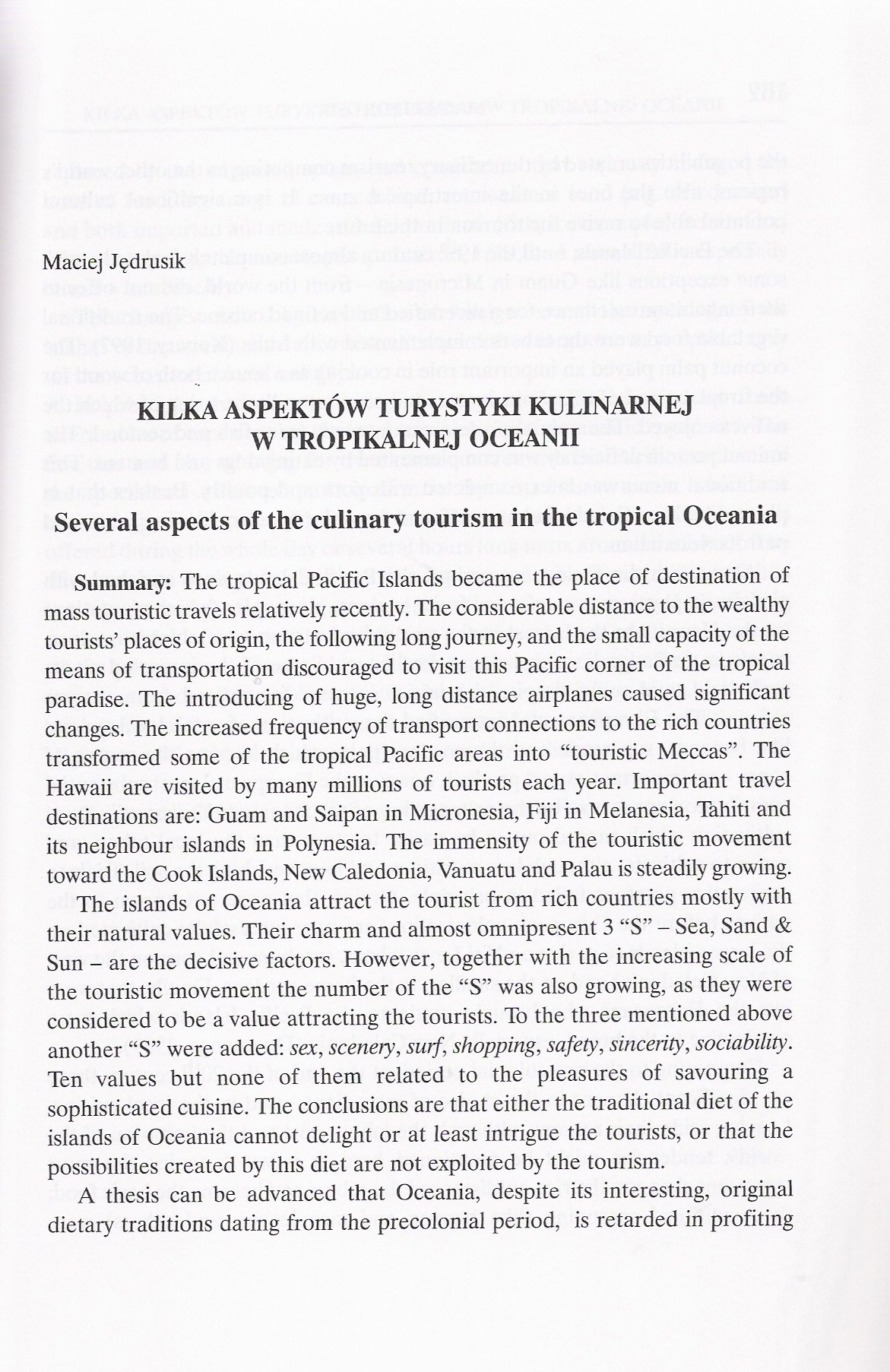66443 skanuj0041 (52)

Maciej Jędrusik
KILKA ASPEKTÓW TURYSTYKI KULINARNEJ W TROPIKALNEJ OCEANII
Several aspects of the culinary tourism in the tropical Oceania
Summary: The tropical Pacific Islands became the place of destination of mass touristic travels relatively recently. The considerable distance to the wealthy tourists’ places of origin, the following long journey, and the smali capacity of the means of transportation discouraged to visit this Pacific corner of the tropical paradise. The introducing of huge, long distance airplanes caused significant changes. The increased freąuency of transport connections to the rich countries transformed some of the tropical Pacific areas into “touristic Meccas”. The Hawaii are visited by many millions of tourists each year. Important travel destinations are: Guam and Saipan in Micronesia, Fiji in Melanesia, Tahiti and its neighbour islands in Polynesia. The immensity of the touristic movement toward the Cook Islands, New Caledonia, Vanuatu and Palau is steadily growing.
The islands of Oceania attract the tourist from rich countries mostly with their natural values. Their charm and almost omnipresent 3 “S” - Sea, Sand & Sun - are the decisive factors. However, together with the increasing scalę of the touristic movement the number of the “S” was also growing, as they were considered to be a value attracting the tourists. To the three mentioned above another “S” were added: sex, scenery, surf, shopping, safety, sinceńty, sociability. Ten values but nonę of them related to the pleasures of savouring a sophisticated cuisine. The conclusions are that either the traditional diet of the islands of Oceania cannot delight or at least intrigue the tourists, or that the possibilities created by this diet are not exploited by the tourism.
A thesis can be advanced that Oceania, despite its interesting, original dietary traditions dating from the precolonial period, is retarded in profiting
Wyszukiwarka
Podobne podstrony:
54891 skanuj0043 (48) 163 KILKA ASPEKTÓW TURYSTYKI KULINARNEJW TROPIKALNEJ OCEANII replaced by the i
skanuj0053 (34) 173 KILKA ASPEKTÓW TURYSTYKI KULINARNEJW TROPIKALNEJ OCEANII ściach norii owiniętego
skanuj0055 (30) 175 KILKA ASPEKTÓW TURYSTYKI KULINARNEJW TROPIKALNEJ OCEANII 3.4. Kava - skarb Pacyf
skanuj0057 (27) 177 KILKA ASPEKTÓW TURYSTYKI KULINARNEJW TROPIKALNEJ OCEANII Literatura Crocombe R.,
skanuj0057 (27) 177 KILKA ASPEKTÓW TURYSTYKI KULINARNEJW TROPIKALNEJ OCEANII Literatura Crocombe R.,
47728 skanuj0053 (34) 173 KILKA ASPEKTÓW TURYSTYKI KULINARNEJW TROPIKALNEJ OCEANII ściach norii owin
65503 skanuj0047 (44) 167 KILKA ASPEKTÓW TURYSTYKI KULINARNEJW TROPIKALNEJ OCEANII scowych m.in. ban
47728 skanuj0053 (34) 173 KILKA ASPEKTÓW TURYSTYKI KULINARNEJW TROPIKALNEJ OCEANII ściach norii owin
23536 skanuj0055 (30) 175 KILKA ASPEKTÓW TURYSTYKI KULINARNEJW TROPIKALNEJ OCEANII 3.4. Kava - skarb
skanuj0049 (44) KILKA ASPEKTÓW TURYSTYKI KULINARNEIW TROPIKALNEJ OCEANII 169 gotowane ryby, pieczone
51397 skanuj0051 (35) KILKA ASPEKTÓW TURYSTYKI KULINARNEJW TROPIKALNEJ OCEANII 171 raz częściej sięg
więcej podobnych podstron